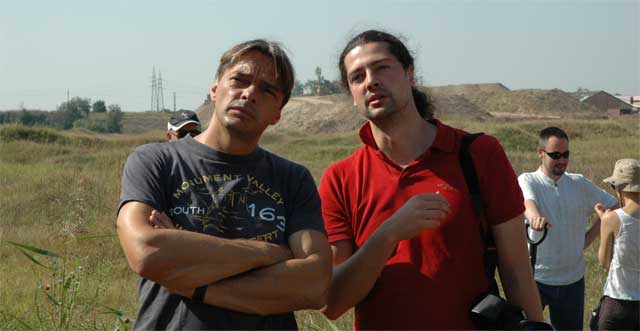LOESSFEST'09 | Aug. 31st – Sept. 3rd, 2009 |Novi Sad-Serbia
A Continuous, High Resolution Dust Record Over the Last 133 Ka for Central Europe (Eifel, Western Germany), Focussing on the Reconstruction of Extreme Storm Events and Paleo Wind Directions
Klemens Seelos1, Stephen Dietrich1
1Institute for Geosciences, Johannes Gutenberg-University, Becherweg 21, 55099 Mainz, Germany
The last glacial cycle in Central Europe is dominated by processes of aeolian dust transport and accumulation. These dust deposits are preserved in soils and lake sediments and provide detailed information about the climate variability during cold and dry periods. Especially the transitions from warm into cold periods are characterized by turbulent climate conditions.

The main problems of terrestrial paleoclimate reconstructions are the completeness of the core material and a sampling resolution. To detect single dust storms we use a particle detection method, which allows high resolution, sub-annual analyses of sediment structures in undisturbed samples. The ELSA (Eifel Laminated Sediment Archive) stack is a compilation of four different lake sediment cores of the Eifel region (Western Germany) and comprise the period of the last 133 ka.
The results of our analyses show high frequencies of dust storm events during the first cold events C24 and C23 after the last warm stage. In opposition, the coldest periods of the last glacial cycle OIS-4 (70 – 60 ka BP) and OIS-2 (35 – 14 ka BP) are characterized by stable climate conditions that provide the accumulation of homogenous dust sediments.
The second dataset, the ELSA wind direction reconstruction depends on provenance analyses of wind transported carbonates. This continuous record over the period 40.3-12.8 ka has an original sample interval of 500 μm, which is equivalent with a mean time resolution of about four month. To calculate the east wind activity for a fixed 100 years interval, all single 500 μm segments that show east wind activity are summed after the time correlation procedure.
Regarding the whole record, west winds are dominating the period 40.3 – 12.8 ka BP. The maximum content of east wind formed sediments in a hundred years interval is 19.4 % (32 ka BP), the lowest activity about 2%, respectively the highest west wind activity detected during the period 24 – 22.5 ka BP. With the transition into OIS 2 (35 ka BP), the content of east wind sediments increases permanently and is relatively stable until the Heinrich-2 event (24 ka BP). During the initial phase of OIS-2 thick east wind layers are accumulated, but the frequency of east wind activity is low.
During the following period (35 – 24 ka) the content of dust sediments is always high (~ 75 %), in opposition the content of organics decreases to a very low level. The period between Heinrich-2 and the LGM (20 – 18 ka BP) is characterized by a principle change in the climate system over Europe. The content of east wind transported sediments drop to a level around 2 %. The content of organics reaches a maximum during DO2 (22.5 – 21 ka BP). During the LGM (20–18 ka BP) and the subsequent Heinrich-1 event (~ 16 ka BP) the content of east wind sediments is once again noticeable high.



